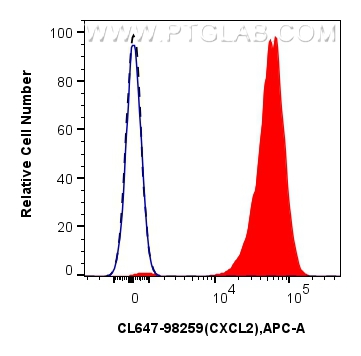验证数据展示
经过测试的应用
| Positive FC (Intra) detected in | LPS and Brefeldin A treated RAW 264.7 cells |
推荐稀释比
| 应用 | 推荐稀释比 |
|---|---|
| Flow Cytometry (FC) (INTRA) | FC (INTRA) : 0.25 ug per 10^6 cells in a 100 µl suspension |
| This reagent has been tested for flow cytometric analysis. It is recommended that this reagent should be titrated in each testing system to obtain optimal results. | |
| Sample-dependent, Check data in validation data gallery. | |
产品信息
CL647-98259 targets CXCL2 in FC (Intra) applications and shows reactivity with mouse samples.
| 经测试应用 | FC (Intra) Application Description |
| 经测试反应性 | mouse |
| 免疫原 |
CatNo: Eg2239 Product name: Recombinant Mouse CXCL2 protein (rFc Tag) (HPLC verified) Source: mammalian cells-derived, pHZ-KIsec-N-rFc Tag: N-rFc Domain: 28-100 aa of NM_009140 Sequence: AVVASELRCQCLKTLPRVDFKNIQSLSVTPPGPHCAQTEVIATLKGGQKVCLDPEAPLVQKIIQKILNKGKAN 种属同源性预测 |
| 宿主/亚型 | Rabbit / IgG |
| 抗体类别 | Recombinant |
| 产品类型 | Antibody |
| 全称 | chemokine (C-X-C motif) ligand 2 |
| 别名 | 242007G5, C-X-C motif chemokine 2, Macrophage inflammatory protein 2, MIP2, Mip-2 |
| 计算分子量 | 11 kDa |
| GenBank蛋白编号 | NM_009140 |
| 基因名称 | Cxcl2 |
| Gene ID (NCBI) | 20310 |
| 偶联类型 | CoraLite® Plus 647 Fluorescent Dye |
| 最大激发/发射波长 | 654 nm / 674 nm |
| 形式 | Liquid |
| 纯化方式 | Protein A purification |
| UNIPROT ID | P10889 |
| 储存缓冲液 | PBS with 0.09% sodium azide, pH 7.3. |
| 储存条件 | Store at 2-8°C. Avoid exposure to light. Stable for one year after shipment. |
背景介绍
CXCL2 is a member of the CXC subfamily, which encodes secreted proteins involved in immunoregulatory and inflammatory processes. CXCL2 is expressed at sites of inflammation and may suppress hematopoietic progenitor cell proliferation. CXCL2 plays an critical role in maintaining cancer-induced macrophage infiltration and the resulting mechanical hypersensitivity and persistent spontaneous nociception (PMID: 36754246).
实验方案
| Product Specific Protocols | |
|---|---|
| FC protocol for CL Plus 647 CXCL2 antibody CL647-98259 | Download protocol |
| Standard Protocols | |
|---|---|
| Click here to view our Standard Protocols |

